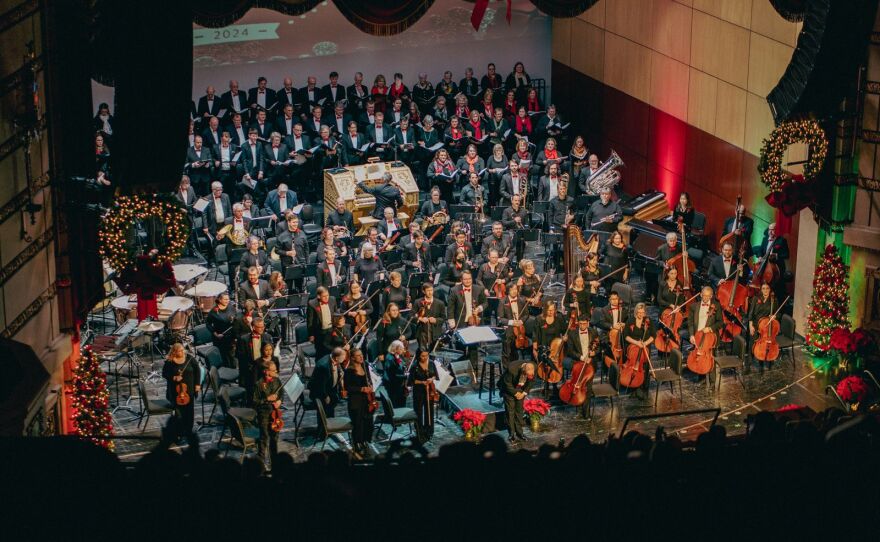When the Sioux City Symphony takes the stage on Saturday, its program will include a new work written by one of its own musicians. Concerto for Oboe, composed and performed by principal oboist Jeffrey Paul, mixes classical with contemporary.
“Definitely, parts of it will sound classical, but you're probably not going to think of Mozart or Beethoven when you hear this piece,” Paul said.
Paul’s music is unique. It melds elements of jazz, north Indian classical and parts Lebanese, pop and progressive rock. But what's more — the piece he created required Paul to create an entirely new instrument in order to play it.

“Definitely, parts of it will sound classical, but you're probably not going to think of Mozart or Beethoven when you hear this piece.”Jeffrey Paul, Sioux City Symphony Orchestra
Finding the right sound
Paul encountered a problem when pursuing perfection. What he imagined in his head didn’t come through his fingers. He needed an instrument to quickly slide between pitches.
“The modern oboe has so many complex key mechanisms and levers and springs and all that, and it's quite a beautiful instrument and you can do many amazing things with it. But not that,” he said of the issue. “I wanted an oboe that essentially used Irish pennywhistle fingering systems. And that's turning out to be a lot more difficult than it looks. I thought it would be so simple.”
Paul spent a year on the music and months researching, reaching out to more than 40 instrument-makers to find something more nuanced. He needed something new that would allow him to use the double reed of an oboe and still get a hauntingly rich tone.
Initially, he didn't get much positive response.
“Nearly all of them said, ‘You're nuts. You're crazy. This can't be done. If it could be done, it would not be worth the time for engineering and all of this,’" Paul said. "And I'm sitting here going, 'This cannot be true. It just can't be true.'"
Paul didn’t give up, and eventually found two creators willing to take on the project.

The first, Richardo Simian, a Ph.D. student in Oslo, Norway, designs hybrid instruments with a 3D printer as part of his studies.
“His response to my cold email inquiry was like, ‘This sounds interesting. It's right, exactly in line with what I'm kind of working on. And I don't think anybody has done this yet,'" Paul said.
Paul received five prototypes with slight changes in dimensions. The most promising model looks like a large, plastic, navy blue recorder with a swirling design near the bottom. But its intonation was a problem.
“Certain intervals are not as in tune as I'd like them to be," Paul said.
So, Paul turned to the maker in France for something already invented in 1983 called the piston. They met virtually to plan a custom-made creation.
“The fellow who made this instrument for me — Eric Ollu — he harvested Brextonian boxwood in 1990 and has been aging it ever since. So, he used that wood to make my instrument,” Paul said. “And it's just so special and beautiful. There are some ring accents on there that are made out of cow horn. And some, what they call alpaca or German silver key work on there. Not a lot of keys, as you can see, but there are a couple.”
Innovation meets creativity
Jean-Francois Charles, a graduate of Harvard who now specializes in music and technology as an associate professor at the University of Iowa, teaches a class where students make their own instruments.
“It’s great that the composer and performer is looking for new sounds,” Charles said.

Charles is a native of France, and at one time lived in the region where the piston was built, but said he wasn’t aware of the instrument. He says it's similar to a baroque oboe used many centuries ago.
Charles credits Paul with pursuing a tradition of innovation sparked by composers like Mozart and Bach. He compared him to composer and virtuoso violinist Niccolo Paganini, who, for a while, was the only person able to play his own pieces because they were so difficult.
"Many composers have been very inspired by new musical instruments,” Charles said. “But it's really completely new to have a new piece of music in the context of a full orchestra, classical orchestra for this instrument, and from what I understand, it might really be a premiere.”
"It's really completely new to have a new piece of music in the context of a full orchestra."Jean-Francois Charles, University of Iowa
Opening night notes
Jeffrey Paul admits to having opening night nerves, but he's eager for an audience to enjoy his music in a way never heard before on the piston.
“Now that I've seen the potential of these kinds of sounds, I intend to continue writing for them. And I think that's going to mean quite a long journey of trying to refine this. This kind of process is sort of like a simplified modern oboe,” Paul said.
Paul's journey included measured complexity where others can enjoy the notes along the way.















